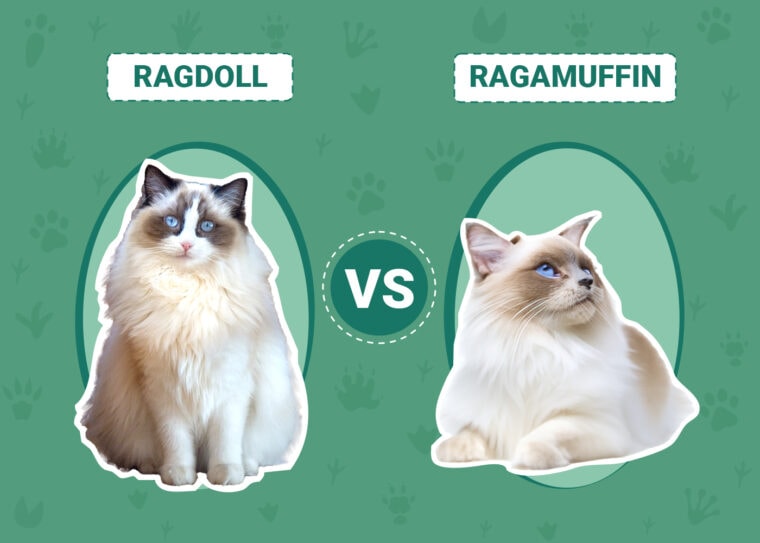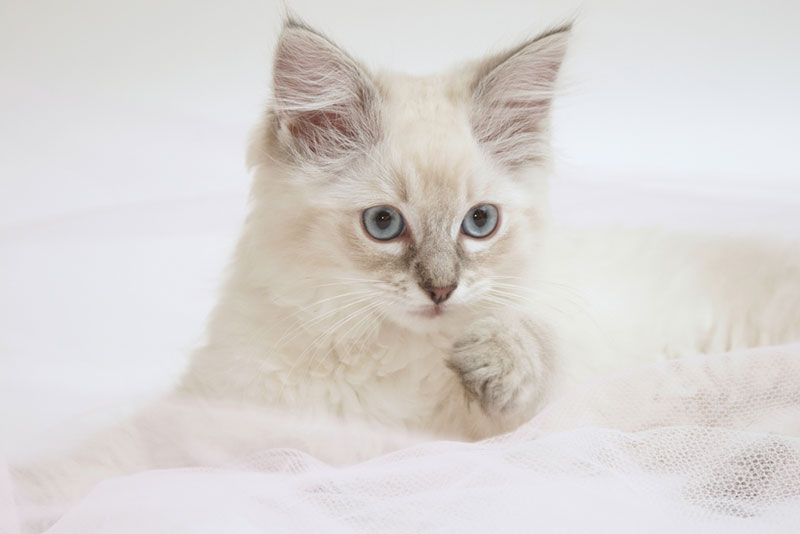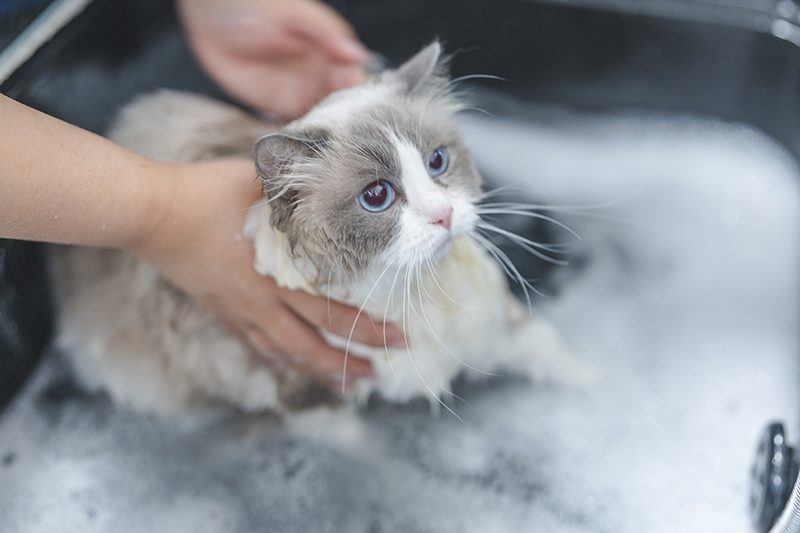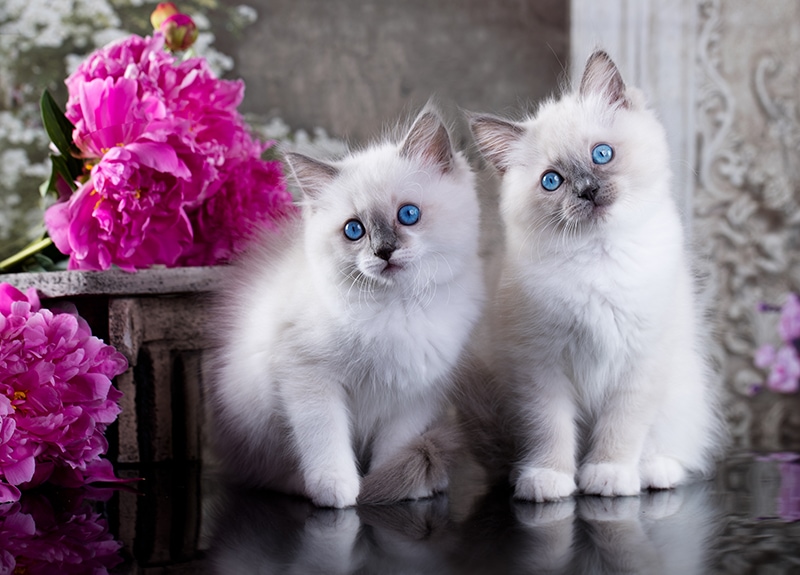
Click to Skip Ahead
The Ragdoll and Ragamuffin breeds were developed in Southern California and are two of the newest purebred kitties to emerge globally. Ragdolls came first, in the 1960s, with Ragamuffins first developed in 1994. With their gorgeous coats and large size, the Ragdoll and the Ragamuffin make quite an impression the first time you see one. If you’re curious about how these two California native breeds differ, you’ve come to the right place. Keep reading for a side-by-side comparison of the Ragdoll and Ragamuffin. If you’re considering buying or adopting either of these breeds, this article can help you decide which is the best choice for you and your family.
Visual Differences

At a Glance
Ragdoll Overview

Personality
Ragdolls are among the gentlest, calmest, people-loving cat breeds. Even people who say they don’t like cats are in danger of being charmed by this social kitty. Ragdolls love their humans of all ages and will often follow them around the house or run to greet them when they come home.
These fluffy felines extend their goodwill to other four-legged family members as well. They typically get along with dogs and other cats, especially when socialized with them as kittens. Ragdolls are not the most active cats and prefer to spend most of the day relaxing or cuddling.
Ragdolls are non-confrontational cats who should live indoors only. They are also one of the most easily trained cat breeds and respond well to food rewards to learn tricks and commands.
Grooming
Ragdolls have a medium-long, luscious hair coat that is incredibly soft. They shed, but their fur doesn’t tangle easily. You can comb out their coats once or twice a week to remove dead hair and keep the fur healthy.
For the best results, teach your Ragdoll kitten to accept a grooming routine when they’re kittens. Ragdolls may experience heavier shedding seasonally and require more frequent grooming. Although it’s unusual for cats, Ragdolls generally like water and may tolerate regular baths.
Keep their nails trimmed short and check their ears regularly. Preventative dental care is also important for Ragdolls. If any cat will accept having their teeth brushed, it is the Ragdoll!

Health & Care
Ragdolls can suffer from an inherited heart condition called hypertrophic cardiomyopathy. However, genetic testing has helped decrease the frequency of this issue. Bladder stones are also common in the breed. Although they are naturally large cats, Ragdolls can suffer from joint issues if they become overweight. Allergies—both food and seasonal—are also a frequent concern for Ragdoll cats.
Suitable For:
Ragdolls are suitable for cat lovers of all kinds. They are calm enough to serve as cuddle companions for seniors and tolerant enough to endure the attention of children. Multi-pet families are also ideal for the social Ragdoll. The only thing Ragdolls really don’t like is being lonely. If you’re a busy person looking for an independent breed happy to hang out on their own, the Ragdoll probably isn’t the cat for you.
Ragamuffin Overview

Personality
Ragamuffins are extremely affectionate and tolerant cats. Not only do they love people, but they also enjoy interacting with them too. If you need a quiet (fluffy) ear to listen to you vent about your frustrating co-worker, the Ragamuffin is happy to oblige.
These beautiful cats are especially good with kids. Since they’re gentle and adaptable, they are happy to play dress up or be pushed in a stroller by respectful children. Ragamuffins also enjoy playing with toys and have more energy than the closely related Ragdoll.
Ragamuffins usually get along with other pets and have little interest in hunting. They can learn to walk on a leash but should always be supervised outdoors.
Grooming
Ragamuffins have a thick, medium-length coat with a soft texture. They shed but typically don’t develop mats like other breeds with longer fur. You can comb or brush them weekly to remove loose hair. Besides that, Ragamuffins have only basic grooming needs. Regular nail trims, dental care, and ear cleaning as needed should be sufficient to keep them looking fine and healthy.

Health & Care
Ragamuffins can suffer from cardiomyopathy, which is a common heart condition of many purebred cats. They can also inherit a condition called polycystic kidney disease. When searching for a breeder, ask if they perform heart checkups and genetic testing for these conditions.
Suitable For:
Like Ragdolls, Ragamuffins are happy in almost any living situation. They are quiet and undemanding, making them a good choice for apartments or senior living communities. Families with kids and other pets will find the Ragamuffin fits right in with everyone. As long as you don’t expect these gentle cats to live outside, they are suitable for you!
So How Exactly Are These Cats Different?
If your conclusion after reading the overview of these two breeds is that they are very similar, you aren’t wrong. The Ragamuffin was developed from the Ragdoll, which is why the breeds have so much in common. The major differences between the Ragdoll and Ragamuffin are in physical characteristics.

Coat Color
Ragdolls can only have light cream or white coats with darker points, like a Siamese cat, with patterns such as bi-color and mitted. In contrast, Ragamuffins are found in nearly every color and pattern, including tabby, calico, and tortoiseshell.
Eye Color
The Ragdoll’s brilliant blue eyes are one of their distinguishing features. Ragamuffins can have eyes of several different colors, including golden and green.
Head Shape
Ragamuffins were developed by crossing Ragdolls with Persians and Himalayans, among other breeds. These genetics gave the Ragamuffin a rounder, more wedge-shaped head than the Ragdoll.
Which Breed Is Right for You?
As we’ve learned, the Ragdoll and the Ragamuffin are very similar cats that make excellent pets for pretty much anyone. The question of which breed is right for you may come down to personal preference, convenience, and cost. Ragdoll breeders are typically easier to find than those who breed Ragamuffins since they haven’t been around as long. Ragamuffins may cost more to buy because they are the rarer of the two breeds. Whether the Ragdoll or Ragamuffin captures your heart, be vigilant about selecting a breeder who performs the health checks and screenings we discussed in this article.
Featured Image Credit: Top – Ivelin Donchev, Pexels | Bottom – Scampi, Shutterstock







